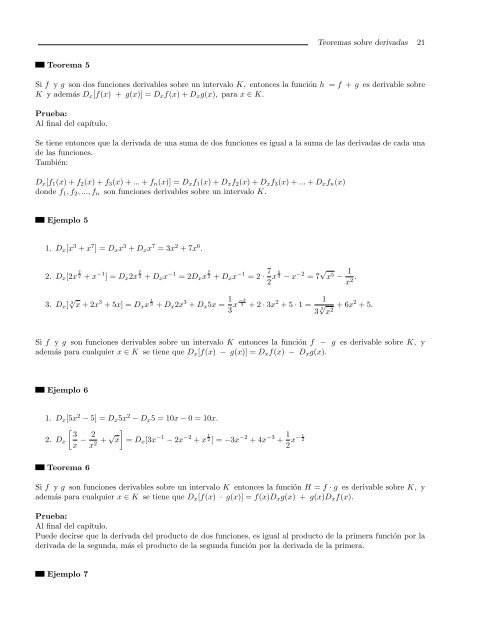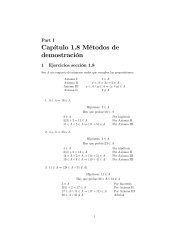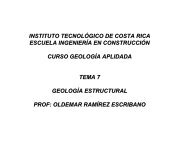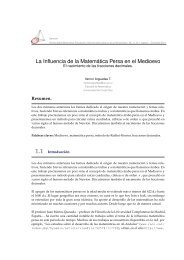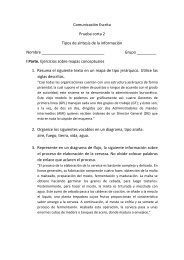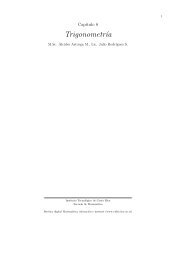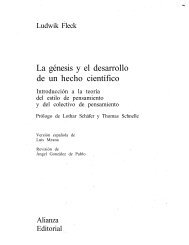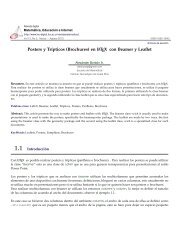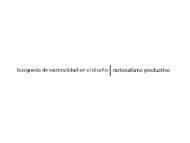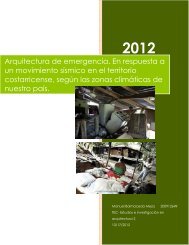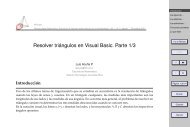Derivada de una función - TEC-Digital
Derivada de una función - TEC-Digital
Derivada de una función - TEC-Digital
Create successful ePaper yourself
Turn your PDF publications into a flip-book with our unique Google optimized e-Paper software.
Teorema 5<br />
Teoremas sobre <strong>de</strong>rivadas 21<br />
Si f y g son dos funciones <strong>de</strong>rivables sobre un intervalo K, entonces la <strong>función</strong> h = f + g es <strong>de</strong>rivable sobre<br />
K y a<strong>de</strong>más Dx[f(x) + g(x)] = Dxf(x) + Dxg(x), para x ∈ K.<br />
Prueba:<br />
Al final <strong>de</strong>l capítulo.<br />
Se tiene entonces que la <strong>de</strong>rivada <strong>de</strong> <strong>una</strong> suma <strong>de</strong> dos funciones es igual a la suma <strong>de</strong> las <strong>de</strong>rivadas <strong>de</strong> cada <strong>una</strong><br />
<strong>de</strong> las funciones.<br />
También:<br />
Dx[f1(x) + f2(x) + f3(x) + ... + fn(x)] = Dxf1(x) + Dxf2(x) + Dxf3(x) + ... + Dxfn(x)<br />
don<strong>de</strong> f1, f2, ..., fn son funciones <strong>de</strong>rivables sobre un intervalo K.<br />
Ejemplo 5<br />
1. Dx[x 3 + x 7 ] = Dxx 3 + Dxx 7 = 3x 2 + 7x 6 .<br />
2. Dx[2x 7<br />
2 + x −1 ] = Dx2x 7<br />
2 + Dxx −1 = 2Dxx 7<br />
2 + Dxx −1 = 2 · 7 5<br />
x 2 − x<br />
2 −2 = 7 √ x5 − 1<br />
.<br />
x2 3. Dx[ 3√ x + 2x 3 + 5x] = Dxx 1<br />
3 + Dx2x 3 + Dx5x = 1 −2<br />
x 3 + 2 · 3x<br />
3 2 + 5 · 1 = 1<br />
3 3√ x2 + 6x2 + 5.<br />
Si f y g son funciones <strong>de</strong>rivables sobre un intervalo K entonces la <strong>función</strong> f − g es <strong>de</strong>rivable sobre K, y<br />
a<strong>de</strong>más para cualquier x ∈ K se tiene que Dx[f(x) − g(x)] = Dxf(x) − Dxg(x).<br />
Ejemplo 6<br />
1. Dx[5x 2 − 5] = Dx5x 2 − Dx5 = 10x − 0 = 10x.<br />
2. Dx<br />
<br />
3 2<br />
−<br />
x x2 + √ <br />
x<br />
Teorema 6<br />
= Dx[3x −1 − 2x −2 + x 1<br />
2 ] = −3x −2 + 4x −3 + 1<br />
2<br />
Si f y g son funciones <strong>de</strong>rivables sobre un intervalo K entonces la <strong>función</strong> H = f · g es <strong>de</strong>rivable sobre K, y<br />
a<strong>de</strong>más para cualquier x ∈ K se tiene que Dx[f(x) · g(x)] = f(x)Dxg(x) + g(x)Dxf(x).<br />
Prueba:<br />
Al final <strong>de</strong>l capítulo.<br />
Pue<strong>de</strong> <strong>de</strong>cirse que la <strong>de</strong>rivada <strong>de</strong>l producto <strong>de</strong> dos funciones, es igual al producto <strong>de</strong> la primera <strong>función</strong> por la<br />
<strong>de</strong>rivada <strong>de</strong> la segunda, más el producto <strong>de</strong> la segunda <strong>función</strong> por la <strong>de</strong>rivada <strong>de</strong> la primera.<br />
Ejemplo 7<br />
x− 1<br />
2


